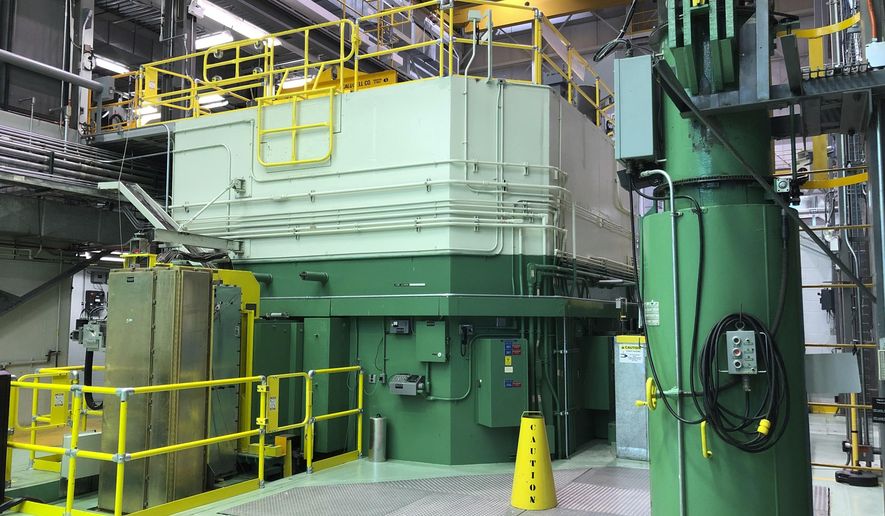SALT LAKE CITY (AP) - The Utah Taxpayers Association and a former member of the U.S. Nuclear Regulatory Commission are urging cities that have signed on to a planned nuclear power plant in Idaho to get out while they can before costs become too great.
NuScale’s Small Modular Reactor is planned for construction at the Idaho National Laboratory near Idaho Falls and would provide 720 megawatts of power, or enough energy for 720,000 homes.
The Carbon Free Power Project is promoted as the next generation design for nuclear power, featuring 12 distinct modules, with the first scheduled to come online in 2029 with the 11 others following the next year.
The project is a collaborative effort involving the U.S. Department of Energy, NuScale and the Utah Associated Municipal Power Systems, a political subdivision of the state of Utah. That group is made up of cities and special service districts in six states and was established to provide power, transmission and other electrical-related services on a nonprofit basis.
“If members determine there is too much risk the project will not go forward,” said spokesman LaVarr Webb. “That is why many, many steps have been taken to de-risk the project and why it is going forward in phases. … It is also important to remember this will represent only a portion of their energy portfolio.”
Webb said there are several off-ramps in those phases for cities to exit, one of which is coming up Sept. 14. That deadline prompted the taxpayers association to urge cities to get out now before they get trapped into paying millions for a technology it says is unproven.
“Small modular reactor power is just not cost competitive,” said Rusty Cannon, vice president of the taxpayer group, adding participating cities and districts should hold a public vote to withdraw from the project.
Cannon, in a teleconference Tuesday, pointed to Bountiful’s costs as an example - which after May 2023 will increase to roughly $1.4 million.
Based on its percentage of participation and current levels of subscription to the power, Bountiful’s costs would be a little more than $21 million to be paid over 40 years through electricity rates. The plant is expected to last a minimum of 60 years and possibly 80 years.
Cannon said 30% of the power to be generated has been committed or subscribed by participants at this time.
“We just don’t think this is a good idea.”
Webb countered he believes those subscriptions will come.
The project’s design certification is under review by the Nuclear Regulatory Commission and must pass several other regulatory hurdles before construction can begin.
This small modular reactor technology planned for Idaho is significantly smaller than a traditional nuclear power plant, about one-third the size, and is touted for its advanced safety features, including self-cooling and automatic shutdown.
But Peter Bradford, a former member of the U.S. Nuclear Regulatory Commission, said enthusiasm over new developments in nuclear technology that turned out to be flawed have cost ratepayers and taxpayers in multiple states billions of dollars.
He said that of 31 projects pending before the commission in 2009, only two remain - with the rest canceled or indefinitely postponed.
“The stranded costs of nuclear plants paid off by customers in the 1990s exceeded $50 billion nationwide,” he said. “Each period of abject failure is followed by an array of new proposals.”
Several companies globally are in the hunt to be the first to successfully deploy the small modular reactor technology, but NuScale’s design has made the most progress.
The project is backed heavily by the U.S. Department of Energy, which gave NuScale a competitive award of $226 million in 2013 to develop the technology. Two years later, the federal agency gave NuScale $16.7 million for licensing preparation.
Ultimately, the energy department committed to spend $1.4 billion on the project with an eye toward reducing carbon emissions, combating climate change, and to position the country as a world leader in nuclear technology, Webb said.
Cities signing on to add nuclear to their energy portfolio are doing so as a hedge against market volatility with natural gas prices, to counter a regulatory upset that would phase out coal and to add to their renewable sources of electricity.
Cannon and Bradford also criticized the municipal power association for not being transparent enough because its briefing meetings are exempt from the Utah open meetings law and are closed.
But association officials rejected that accusation, pointing to more than more than 120 open meetings that have been held, including a recent six-hour town hall meeting for all stakeholders.
“The public part of this process really comes at the city level,” Webb said.




Please read our comment policy before commenting.